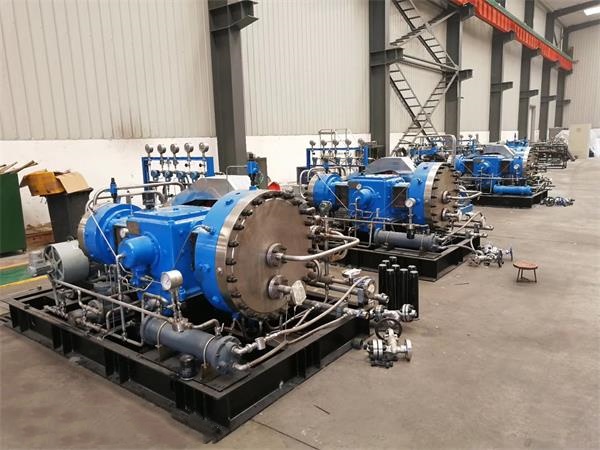Ջրածնային դիֆրագմային կոմպրեսորի էներգախնայողության տեխնոլոգիային և օպտիմալացման պլանին կարելի է մոտենալ բազմաթիվ ասպեկտներից: Ստորև բերված են որոշ կոնկրետ ներածություններ.
1. Կոմպրեսորի կորպուսի նախագծման օպտիմալացում
Գլանի արդյունավետ նախագծում. գլանների նոր կառուցվածքների և նյութերի ընդունում, ինչպիսիք են գլանների ներքին պատի հարթության օպտիմալացումը, ցածր շփման գործակցով ծածկույթների ընտրությունը և այլն,՝ մխոցի և գլանների պատի միջև շփման կորուստները նվազեցնելու և սեղմման արդյունավետությունը բարելավելու համար: Միևնույն ժամանակ, գլանների ծավալային հարաբերակցությունը պետք է նախագծվի ողջամիտ կերպով՝ տարբեր աշխատանքային պայմաններում այն ավելի լավ սեղմման հարաբերակցության հասցնելու և էներգիայի սպառումը նվազեցնելու համար:
Առաջադեմ դիաֆրագմայի նյութերի կիրառումը. Ընտրեք դիաֆրագմայի նյութեր, որոնք ունեն ավելի բարձր ամրություն, ավելի լավ առաձգականություն և կոռոզիայի դիմադրություն, ինչպիսիք են նոր պոլիմերային կոմպոզիտային նյութերը կամ մետաղական կոմպոզիտային դիաֆրագմաները: Այս նյութերը կարող են բարելավել դիաֆրագմայի փոխանցման արդյունավետությունը և նվազեցնել էներգիայի կորուստը՝ միաժամանակ ապահովելով դրա ծառայության ժամկետը:
2, էներգախնայող շարժիչի համակարգ
Փոփոխական հաճախականության արագության կարգավորման տեխնոլոգիա. փոփոխական հաճախականության շարժիչների և փոփոխական հաճախականության արագության կարգավորիչների միջոցով կոմպրեսորի արագությունը կարգավորվում է իրական ժամանակում՝ ջրածնի գազի իրական հոսքի պահանջարկին համապատասխան: Ցածր բեռնվածությամբ աշխատանքի ընթացքում նվազեցրեք շարժիչի արագությունը՝ անվանական հզորությամբ անարդյունավետ աշխատանքից խուսափելու համար, այդպիսով զգալիորեն կրճատելով էներգիայի սպառումը:
Մշտական մագնիսով սինխրոն շարժիչի կիրառումը. Մշտական մագնիսով սինխրոն շարժիչի օգտագործումը՝ որպես շարժիչ շարժիչ, փոխարինելու ավանդական ասինխրոն շարժիչին: Մշտական մագնիսով սինխրոն շարժիչներն ունեն ավելի բարձր արդյունավետություն և հզորության գործակից, և նույն բեռնվածության պայմաններում դրանց էներգիայի սպառումը ցածր է, ինչը կարող է արդյունավետորեն բարելավել կոմպրեսորների ընդհանուր էներգաարդյունավետությունը:
3. Սառեցման համակարգի օպտիմալացում
Սառնարանի արդյունավետ դիզայն. Բարելավեք սառեցնողի կառուցվածքը և ջերմության ցրման մեթոդը, օրինակ՝ օգտագործելով բարձր արդյունավետությամբ ջերմափոխանակման տարրեր, ինչպիսիք են թևավոր խողովակները և թիթեղյա ջերմափոխանակիչները, ջերմափոխանակման մակերեսը մեծացնելու և սառեցման արդյունավետությունը բարելավելու համար: Միաժամանակ, օպտիմալացրեք սառեցման ջրի խողովակի դիզայնը՝ սառեցման ջուրը հավասարաչափ բաշխելու համար սառեցնողի ներսում, կանխելու տեղային գերտաքացումը կամ գերսառեցումը, և նվազեցնելու սառեցման համակարգի էներգիայի սպառումը:
Խելացի սառեցման կառավարում. Տեղադրեք ջերմաստիճանի սենսորներ և հոսքի կառավարման փականներ՝ սառեցման համակարգի խելացի կառավարումն ապահովելու համար: Ավտոմատ կերպով կարգավորեք սառեցնող ջրի հոսքը և ջերմաստիճանը՝ հիմնվելով կոմպրեսորի աշխատանքային ջերմաստիճանի և բեռի վրա, ապահովելով, որ կոմպրեսորը աշխատի ավելի լավ ջերմաստիճանային միջակայքում և բարելավելով սառեցման համակարգի էներգաարդյունավետությունը:
4、 Քսայուղային համակարգի բարելավում
Ցածր մածուցիկության քսայուղի ընտրություն. Ընտրեք ցածր մածուցիկության քսայուղ՝ համապատասխան մածուցիկությամբ և լավ յուղման կատարողականությամբ: Ցածր մածուցիկության քսայուղը կարող է նվազեցնել յուղային թաղանթի կտրման դիմադրությունը, իջեցնել յուղի պոմպի էներգիայի սպառումը և հասնել էներգախնայողության՝ միաժամանակ ապահովելով յուղման ազդեցություն:
Նավթի և գազի բաժանում և վերականգնում. Նավթի և գազի արդյունավետ բաժանման սարքն օգտագործվում է քսայուղը ջրածնային գազից արդյունավետորեն բաժանելու համար, և բաժանված քսայուղը վերականգնվում և վերօգտագործվում է: Սա կարող է ոչ միայն նվազեցնել քսայուղի սպառումը, այլև նվազեցնել նավթի և գազի խառնման հետևանքով առաջացած էներգիայի կորուստը:
5. Գործառնությունների կառավարում և սպասարկում
Բեռի համապատասխանեցման օպտիմալացում. Ջրածնի արտադրության և օգտագործման համակարգի ընդհանուր վերլուծության միջոցով, ջրածնային դիաֆրագմային կոմպրեսորի բեռը բավարար չափով համապատասխանեցվում է՝ խուսափելու համար կոմպրեսորի չափազանց կամ ցածր բեռի տակ աշխատանքից: Սարքավորումների արդյունավետ աշխատանքին հասնելու համար կարգավորեք կոմպրեսորների քանակը և պարամետրերը՝ ըստ իրական արտադրական կարիքների:
Կանոնավոր սպասարկում. Մշակեք խիստ սպասարկման պլան և պարբերաբար ստուգեք, վերանորոգեք և սպասարկեք կոմպրեսորը: Ժամանակին փոխարինեք մաշված մասերը, մաքրեք ֆիլտրերը, ստուգեք կնքման աշխատանքը և այլն՝ ապահովելու համար, որ կոմպրեսորը միշտ լավ աշխատանքային վիճակում լինի և նվազեցնեք սարքավորումների խափանման կամ աշխատանքի անկման պատճառով առաջացած էներգիայի սպառումը:
6. Էներգիայի վերականգնում և համապարփակ օգտագործում
Մնացորդային ճնշման էներգիայի վերականգնում. Ջրածնի սեղմման գործընթացի ընթացքում որոշ ջրածնային գազեր ունեն բարձր մնացորդային ճնշման էներգիա: Մնացորդային ճնշման էներգիայի վերականգնման սարքերը, ինչպիսիք են ընդարձակիչները կամ տուրբինները, կարող են օգտագործվել այս ավելցուկային ճնշման էներգիան մեխանիկական կամ էլեկտրական էներգիայի փոխակերպելու համար՝ հասնելով էներգիայի վերականգնման և օգտագործման:
Կոմպրեսորի աշխատանքի ընթացքում առաջացած ջերմության վերականգնում. օգտագործելով կոմպրեսորի աշխատանքի ընթացքում առաջացած ջերմությունը, ինչպիսիք են սառեցման համակարգից ստացված տաք ջուրը, քսայուղից ստացված ջերմությունը և այլն, այդ ջերմությունը փոխանցվում է այլ միջավայրերի, որոնք պետք է տաքացվեն ջերմափոխանակիչի միջոցով, ինչպիսիք են ջրածնային գազի նախնական տաքացումը, գործարանի տաքացումը և այլն՝ էներգիայի համապարփակ օգտագործման արդյունավետությունը բարելավելու համար։
Հրապարակման ժամանակը. Դեկտեմբերի 27-2024


